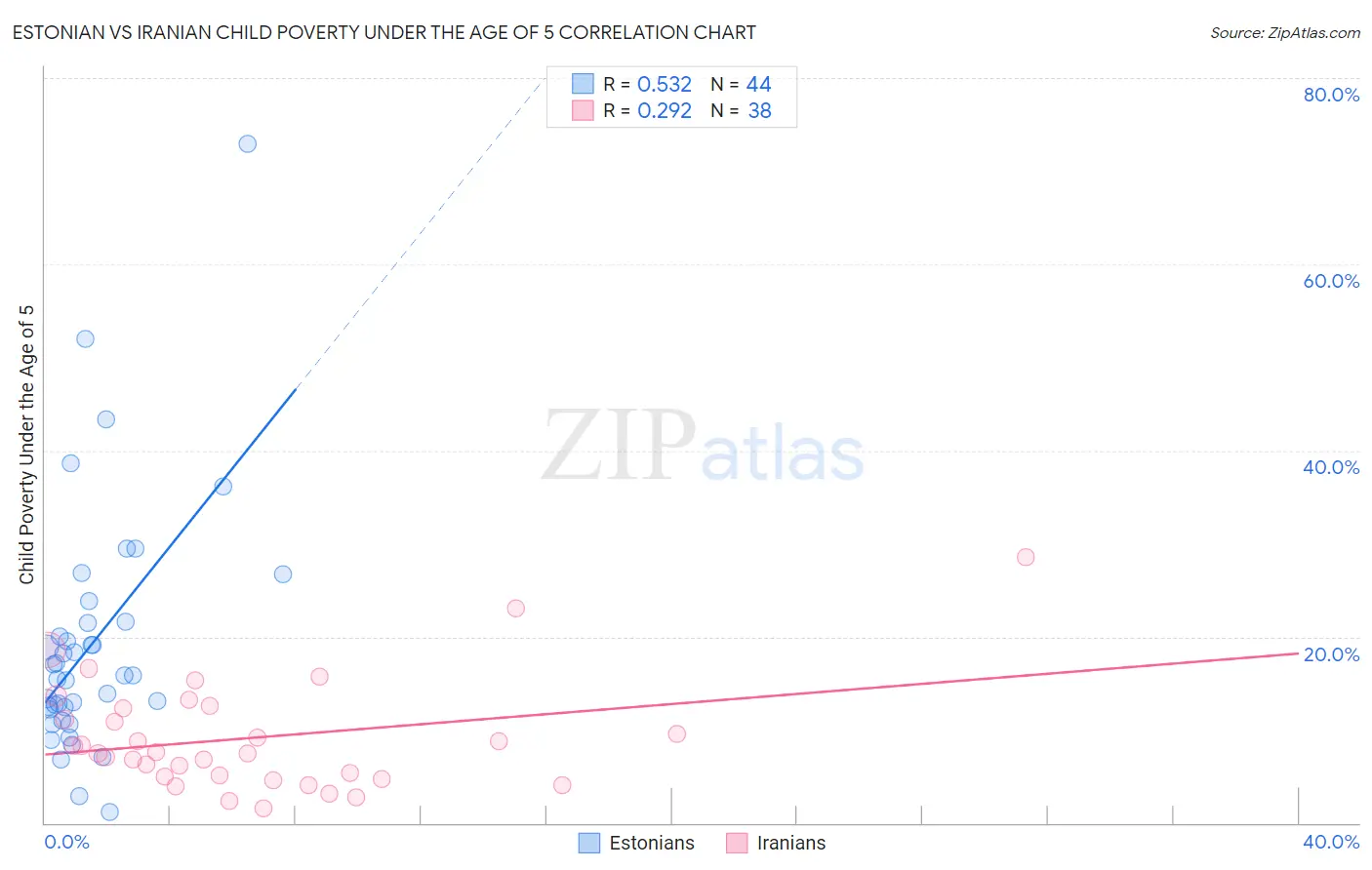Estonian vs Iranian Child Poverty Under the Age of 5
COMPARE
Estonian
Iranian
Child Poverty Under the Age of 5
Child Poverty Under the Age of 5 Comparison
Estonians
Iranians
14.8%
CHILD POVERTY UNDER THE AGE OF 5
99.6/ 100
METRIC RATING
51st/ 347
METRIC RANK
13.1%
CHILD POVERTY UNDER THE AGE OF 5
100.0/ 100
METRIC RATING
8th/ 347
METRIC RANK
Estonian vs Iranian Child Poverty Under the Age of 5 Correlation Chart
The statistical analysis conducted on geographies consisting of 120,177,315 people shows a substantial positive correlation between the proportion of Estonians and poverty level among children under the age of 5 in the United States with a correlation coefficient (R) of 0.532 and weighted average of 14.8%. Similarly, the statistical analysis conducted on geographies consisting of 304,435,638 people shows a weak positive correlation between the proportion of Iranians and poverty level among children under the age of 5 in the United States with a correlation coefficient (R) of 0.292 and weighted average of 13.1%, a difference of 13.4%.

Child Poverty Under the Age of 5 Correlation Summary
| Measurement | Estonian | Iranian |
| Minimum | 1.2% | 1.6% |
| Maximum | 72.9% | 28.6% |
| Range | 71.7% | 27.0% |
| Mean | 19.2% | 9.1% |
| Median | 15.9% | 7.6% |
| Interquartile 25% (IQ1) | 12.3% | 5.0% |
| Interquartile 75% (IQ3) | 21.6% | 12.3% |
| Interquartile Range (IQR) | 9.2% | 7.3% |
| Standard Deviation (Sample) | 13.1% | 5.8% |
| Standard Deviation (Population) | 13.0% | 5.7% |
Similar Demographics by Child Poverty Under the Age of 5
Demographics Similar to Estonians by Child Poverty Under the Age of 5
In terms of child poverty under the age of 5, the demographic groups most similar to Estonians are Immigrants from Northern Europe (14.8%, a difference of 0.040%), Immigrants from Bulgaria (14.8%, a difference of 0.14%), Immigrants from Czechoslovakia (14.8%, a difference of 0.29%), Russian (14.8%, a difference of 0.39%), and Immigrants from Serbia (14.9%, a difference of 0.52%).
| Demographics | Rating | Rank | Child Poverty Under the Age of 5 |
| Immigrants | Philippines | 99.7 /100 | #44 | Exceptional 14.7% |
| Laotians | 99.6 /100 | #45 | Exceptional 14.7% |
| Tsimshian | 99.6 /100 | #46 | Exceptional 14.7% |
| Russians | 99.6 /100 | #47 | Exceptional 14.8% |
| Immigrants | Czechoslovakia | 99.6 /100 | #48 | Exceptional 14.8% |
| Immigrants | Bulgaria | 99.6 /100 | #49 | Exceptional 14.8% |
| Immigrants | Northern Europe | 99.6 /100 | #50 | Exceptional 14.8% |
| Estonians | 99.6 /100 | #51 | Exceptional 14.8% |
| Immigrants | Serbia | 99.5 /100 | #52 | Exceptional 14.9% |
| Luxembourgers | 99.4 /100 | #53 | Exceptional 14.9% |
| Immigrants | Israel | 99.4 /100 | #54 | Exceptional 14.9% |
| Danes | 99.4 /100 | #55 | Exceptional 14.9% |
| Immigrants | Pakistan | 99.4 /100 | #56 | Exceptional 14.9% |
| Egyptians | 99.4 /100 | #57 | Exceptional 14.9% |
| Swedes | 99.4 /100 | #58 | Exceptional 15.0% |
Demographics Similar to Iranians by Child Poverty Under the Age of 5
In terms of child poverty under the age of 5, the demographic groups most similar to Iranians are Chinese (13.1%, a difference of 0.020%), Immigrants from Iran (13.1%, a difference of 0.16%), Immigrants from Singapore (12.9%, a difference of 1.0%), Burmese (13.2%, a difference of 1.3%), and Immigrants from Korea (13.2%, a difference of 1.4%).
| Demographics | Rating | Rank | Child Poverty Under the Age of 5 |
| Immigrants | India | 100.0 /100 | #1 | Exceptional 11.5% |
| Immigrants | Taiwan | 100.0 /100 | #2 | Exceptional 11.6% |
| Filipinos | 100.0 /100 | #3 | Exceptional 11.6% |
| Thais | 100.0 /100 | #4 | Exceptional 12.3% |
| Immigrants | Hong Kong | 100.0 /100 | #5 | Exceptional 12.4% |
| Immigrants | Singapore | 100.0 /100 | #6 | Exceptional 12.9% |
| Chinese | 100.0 /100 | #7 | Exceptional 13.1% |
| Iranians | 100.0 /100 | #8 | Exceptional 13.1% |
| Immigrants | Iran | 100.0 /100 | #9 | Exceptional 13.1% |
| Burmese | 100.0 /100 | #10 | Exceptional 13.2% |
| Immigrants | Korea | 100.0 /100 | #11 | Exceptional 13.2% |
| Immigrants | South Central Asia | 100.0 /100 | #12 | Exceptional 13.3% |
| Bhutanese | 100.0 /100 | #13 | Exceptional 13.4% |
| Okinawans | 100.0 /100 | #14 | Exceptional 13.4% |
| Indians (Asian) | 100.0 /100 | #15 | Exceptional 13.4% |